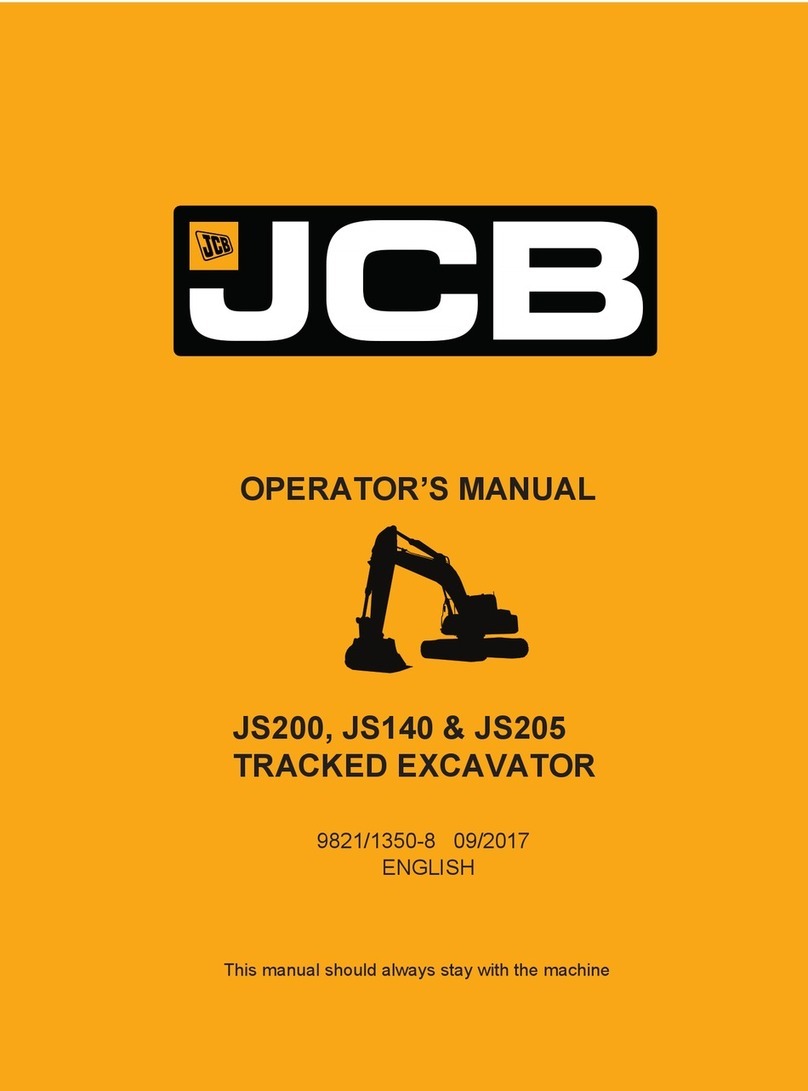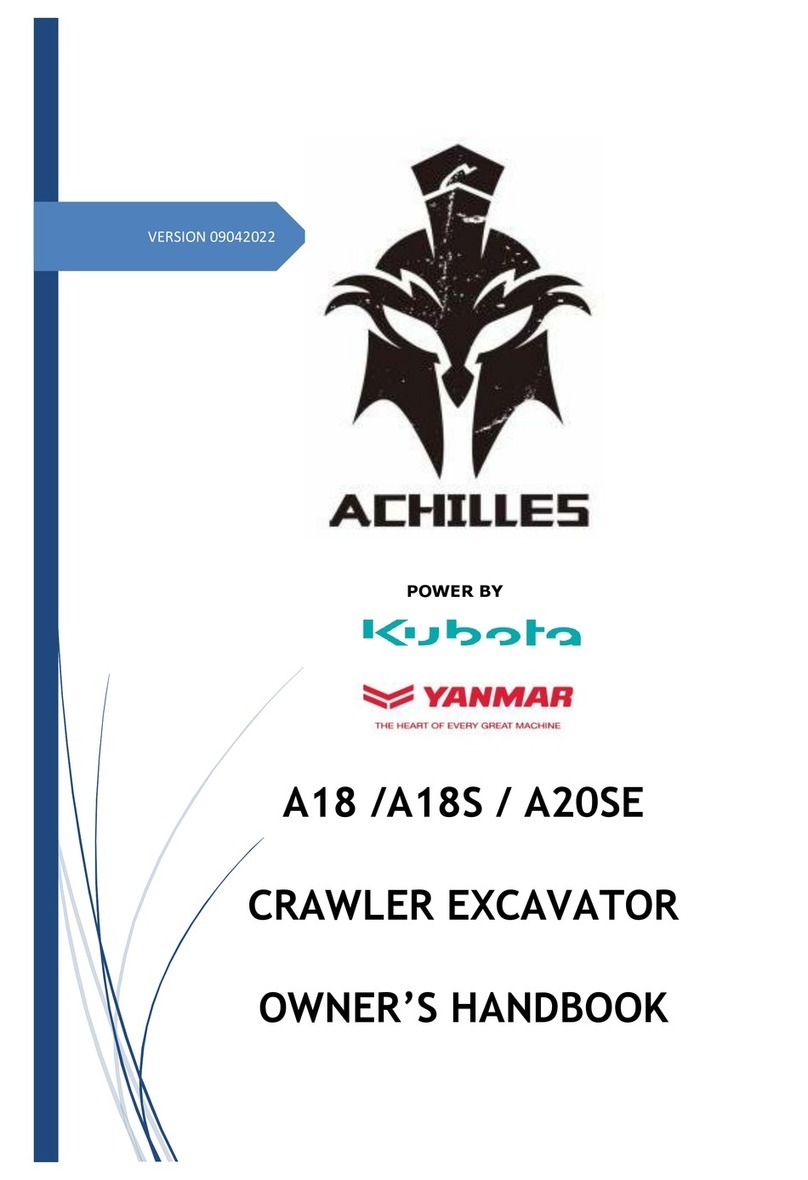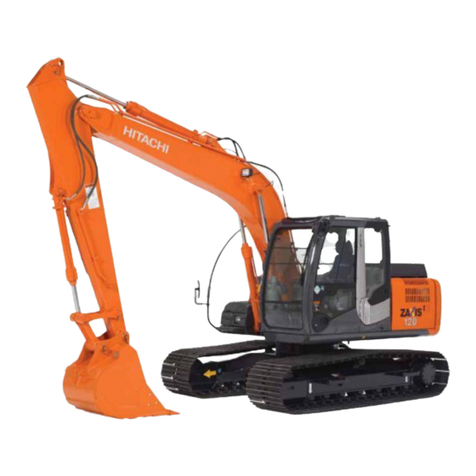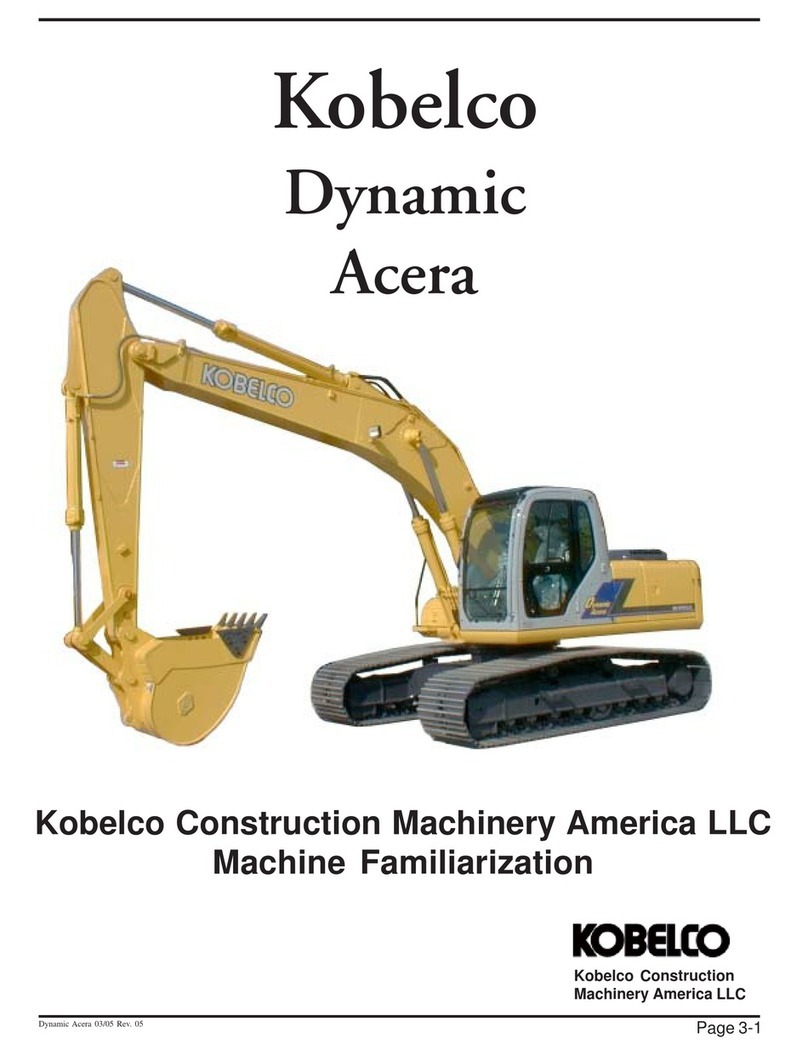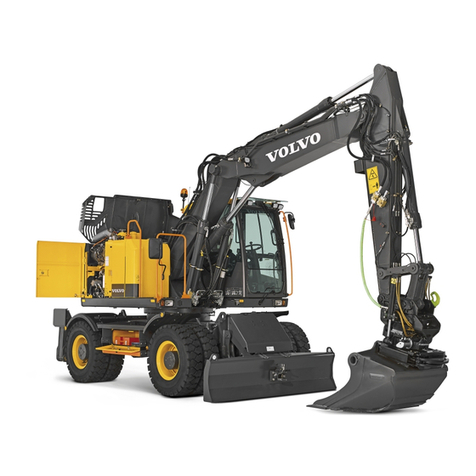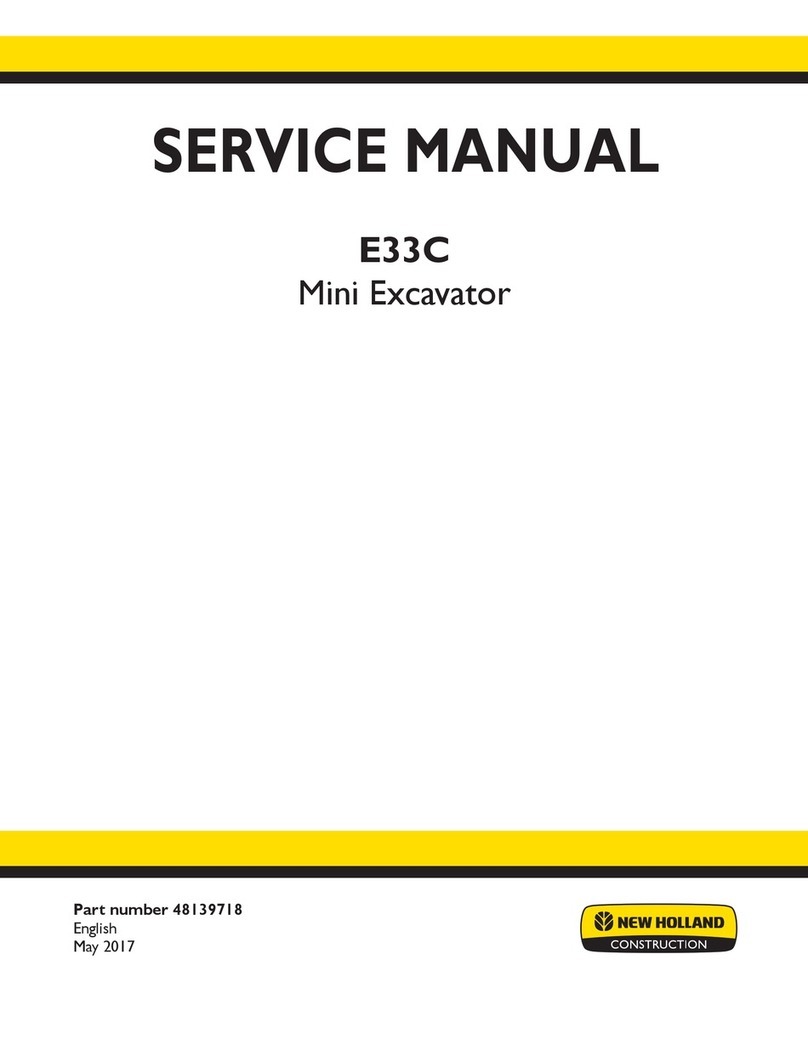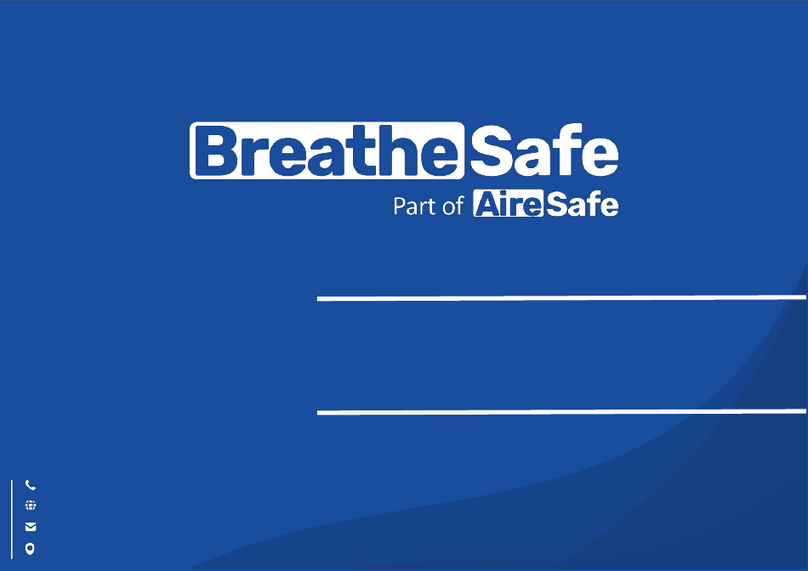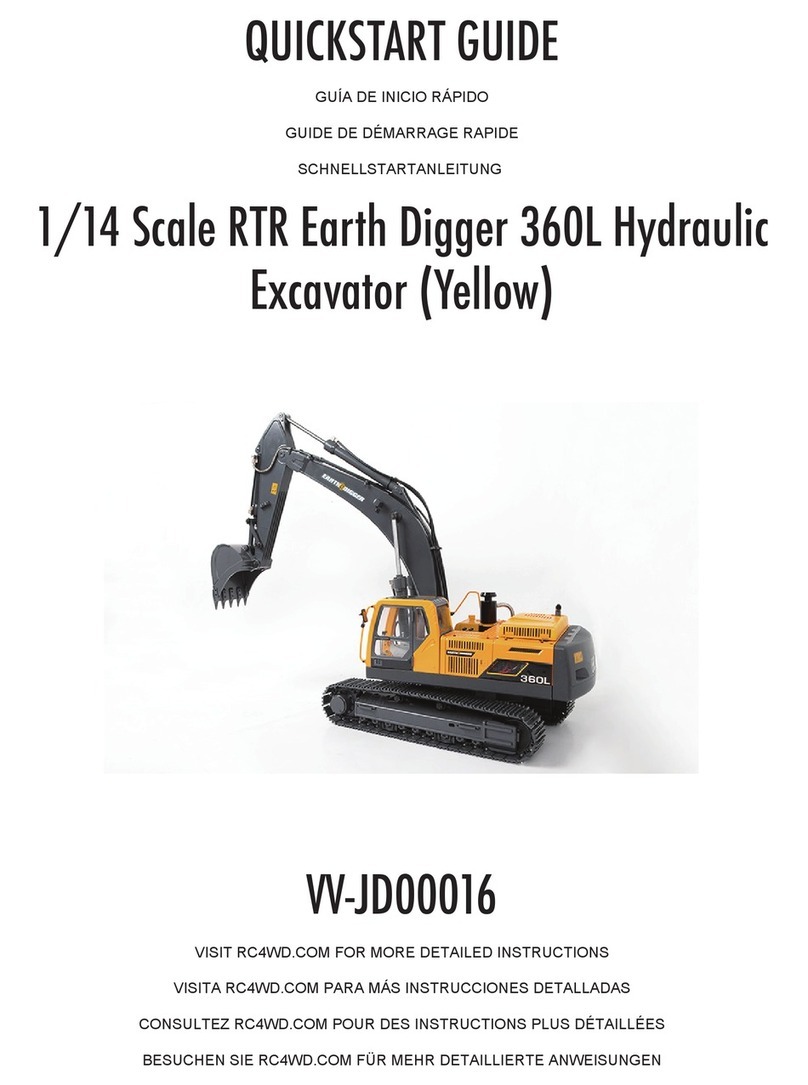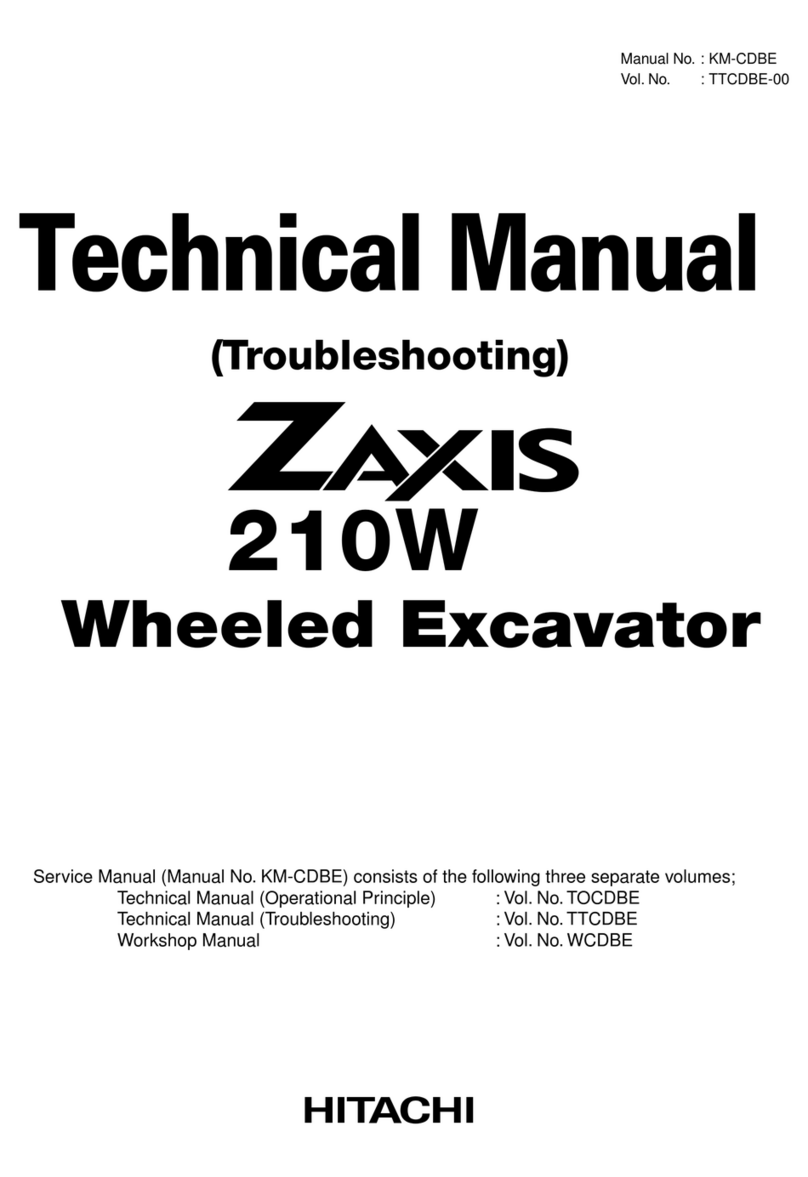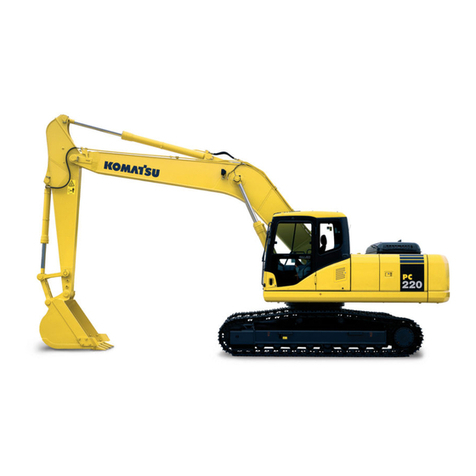EuroDig miniDig GR1000 User manual

- 1 -
PREMESSA
Questo manuale contiene le informazioni necessa-
rie per l’uso, la manutenzione e la lubrificazione
della macchina.
La costante osservanza delle norme in esso conte-
nutedaràcomerisultatounmaggiorenumerodiore
di buon funzionamento ed una sensibile riduzione
delle spese di manutenzione e dei tempi di fermata,
inoltre consente di evitare le più comuni cause di
incidenti che possono verificarsi durante il lavoro e
la manutenzione.
La sicurezza di funzionamento della macchina in
vostro possesso è affidata in prima persona a
coloro che operano quotidianamente su di essa.
E’ quindi importante che gli operatori abbiano det-
tagliate informazioni relativamente al suo corretto
funzionamento, uso e manutenzione.
Il presente opuscolo ha lo scopo di portare a
conoscenza degli operatori le prescrizioni fonda-
mentali ed i criteri da seguire nell’uso e nella
manutenzione della macchina.
Questo manuale deve essere letto dal personale
autorizzato che opera sulla macchina, prima della
sua messa in funzione.
Il presente libretto deve essere sempre tenuto a
bordo macchina o comunque a disposizione degli
operatori.
Le procedure e precauzioni contenute in questo
manuale si intendono applicabili alla macchina solo
per gli usi consentiti.
Èvietatousarelamacchinain modo diver-
so da quello prescritto sul presente ma-
nuale.
INTRODUCTION
This manual contains all the necessary information
on using, maintaining and lubricating the machine.
By carefully following the instructions and regula-
tions contained in this manual, the number of trou-
ble free hours will be increased, the cost of mainte-
nance and downtime will be notably decreased and
the most common causes of accidents during oper-
ating and maintenance will be prevented.
The operating safety of your machine depends
above all on those that operate it every day.
Machine operators therefore need detailed infor-
mation on correct operating, use and maintenance.
This manual aims to alert operators to the funda-
mental regulations and instructions that must be
followed when using and maintaining the machine.
This manual must be read by authorised personnel
operating the machine before it is first started up.
It must be kept on board the machine or in another
place that is readily accessible for the operators.
The procedures and precautions contained in this
manualmust be applied only to authorised machine
operations.
Never use the machine for purposes other
than those described in this handbook.
WARNING !!
ATTENZIONE !!

- 2 -
DEFINIZIONI
Durante la stesura del manuale vengono usati i
termini di ATTENZIONE, AVVERTENZA e NOTA
per evidenziare istruzioni o informazioni considera-
te critiche o inusuali.
Le condizioni che impongono l’uso di tali termini
sono definite come segue:
ATTENZIONE
Informazione o procedura che, se non strettamente
eseguita, può provocare il ferimento o la morte di
persone.
AVVERTENZA
Informazione o procedura che, se non strettamente
eseguita, può provocare notevoli danni alla mac-
china.
NOTA :
Informazione o procedura che può agevolare e
semplificare le operazioni di manutenzione, o co-
munque parte di testo di particolare importanza che
si vuole mettere in evidenza.
ATTENZIONE !!
In questo libretto alcune illustrazioni raffigu-
rano la macchina senza ripari di protezione,
per motivi di chiarezza.
Non utilizzare mai la macchina senza ripari e
non avviare il motore quando il riparo motore
è aperto, se non espressamente prescritto
nelle operazioni di manutenzione.
DEFINITIONS
In this manual the terms WARNING, CAUTION and
NOTICE are used to indicate instructions or infor-
mation considered essential or unusual.
The terms are defined according to the following
criteria:
WARNING
An instruction or procedure that must be strictly
adhered to prevent personal death or injury.
CAUTION
An instruction or procedure that must be strictly
adhered to prevent serious damage to the ma-
chine.
NOTICE:
A piece of information or procedure that may facili-
tate or simplify maintenance or else a particularly
important part of the text that needs to be high-
lighted.
WARNING !!
For the sake of clarity, some of the illustrations
in this manual show the machine without the
safety guards in place
Neverusethemachinewithoutthesafetyguards
in place and never start up the engine if the
engine guard is open, unless this is expressly
prescribed by maintenance operations.

- 3 -
AVVERTENZE GENERALI
1.1 Usi consentiti
1.2 Conducente del mezzo
1.3 Libretto di istruzione e modalità d’uso
1.4 Parti di ricambio
1.5 Assistenza
1.6 Rodaggio della macchina
DATI ANAGRAFICI
2.1 Premessa
2.2 Dati di identificazione
2.3 Dimensioni ed ingombri
2.4 Caratteristiche tecniche
PRESCRIZIONI DI SICUREZZA
3.1 Regole generali
3.2 Salita e discesa dalla macchina
3.3 Quando si abbandona la macchina
PRECAUZIONI PER L'USO
4.1 Prima di iniziare il lavoro
4.2 Quando si lavora
4.3 Lavoro su pendii
4.4 Lavoro in prossimità di condutture
sotterranee
4.5 Lavoro in prossimità di condutture
elettriche
4.6 Trasporto della macchina
INTRODUCTION
Authorised uses 8
Vehicle operator 9
Instruction manual and operating instructions 9
Spare parts 10
Customer Service 10
Running in 10
MACHINE MARKINGS
Introduction 14
Identification data 14
Dimensions and specifications 15
Technical specifications 16
SAFETY REGULATIONS
General rules 18
Getting onto and off the machine 19
Leaving the machine 20
OPERATING PRECAUTIONS
Before starting operations 22
Whilst operating 22
Operating on a gradient 25
Operating near underground pipelines,
telephone lines and high voltage cables 27
Operating near overhead power
cables 28
Transporting the machine 28
Indice Index

- 4 -
4.7 Sollevamento della macchina
4.8 Accumulatore
4.9 Traino della macchina
PRECAUZIONI PER LA MANUTENZIONE
5.1 Regole generali
5.2 Pulizia della macchina
5.3 Uso del motore
5.4 Rifornimenti
5.5 Tubi impianto idraulico
DESCRIZIONE MACCHINA
6.1 Vista generale
6.2 Posto di guida
6.3 Strumentazione cruscotto
6.4 Dispositivi di sicurezza
6.5 Leve comando bracci
6.6 Leva comando lama e allargamento
carro inferiore
6.7 Comando presa di forza e doppia velocità
6.8 Cofano motore
6.9 Sedile
6.10 Allargamento lama
USO DELLA MACCHINA
7.1 Prima di avviare il motore
7.2 Avviamento motore
7.3 Avviamento macchina
7.4 Sterzatura
Lifting the machine 30
Accumulator 31
Towing the machine 33
MAINTENANCE MEASURES
General rules 36
Cleaning the machine 36
Using the engine 37
Refuelling and filling up with oil 37
Hydraulic system piping 38
DESCRIPTION
General View 42
Operator seat 43
Control panel instruments 44
Safety Devices 46
Arms joysticks 48
Blade and enlarging under carriage 49
joystick
Power take off and double speed control 52
Engine cover 53
Seat 53
Blade widening 53
USING THE MACHINE
Before starting up the engine 55
Starting up the engine 55
Starting up the machine 57
Steering 58
Indice Index

- 5 -
Indice Index
7.5 Movimento su un pendio
7.6 Arresto motore
7.7 Uso della benna
7.8 Sostituzione della benna
MANUTENZIONE
8.1 Guida alla manutenzione
8.2 Rifornimenti
8.3 Manutenzione periodica
8.4 Lunghi periodi di inattività
8.5 Accantonamento definitivo
8.6 Schema impianto idraulico
8.7 Schema impianto elettrico
Manoeuvring on a gradient 59
Switching off the engine 60
Using the bucket 60
Changing the bucket 62
MAINTENANCE
Guide to maintenance 65
Refuelling and oil filling 67
Regular maintenance 68
Long periods of inactivity 78
Decommissioning 79
Hydraulic system diagram 80
Electric circuit diagram 82

- 6 -

1
AVVERTENZE GENERALI
1.1 Usi consentiti
1.2 Conducente del mezzo
1.3 Libretto di istruzione e modalità
d’uso
1.4 Parti di ricambio
1.5 Assistenza
1.6 Rodaggio della macchina
INTRODUCTION
1.1 Authorised uses
1.2 Vehicle operator
1.3 Instruction manual and
operating instructions
1.4 Spare parts
1.5 Customer Service
1.6 Running in

- 8 -
1
1.1
AUTHORISED USES
The EURODIG mini-excavators described in this
manual have been manufactured to perform these
main functions:
• Excavator, using different types of buckets;
If the appropriate optional components are fitted,
the machine can also be used for:
• DEMOLITIONWORK(HYDRAULICHAMMER)
• CLEANING OUT AND DIGGING DITCHES
• DRILLING
Never use the machine for purposes other than
those described in this handbook.
The handbooks of any equipment are supplied with
the single pieces of equipment.
CAUTION
EURODIG declines all liability for accidents
involving people or things arising from the fail-
ure to observe the procedures and instructions
contained in this manual and the failure to
comply with safety and accident prevention
regulations
WARNING
If the machine is used in an unauthorised man-
ner the operator is liable for his or her own safety
and for the safety of any other persons involved.
1.1
USI CONSENTITI
I microescavatori EURODIG descritti in questo
manuale sono costruiti per essere usati principal-
mente per eseguire le funzioni di:
• ESCAVATORE, con l’utilizzo di diversi tipi di
benne;
Mediantel’applicazione di attrezzature opzionali, la
macchina può essere usata anche per:
• DEMOLIZIONE (MARTELLO IDRAULICO)
• PULIZIA E CREAZIONE FOSSI
• TRIVELLAZIONI
È vietato usare la macchina per usi diversi da quelli
illustrati sul presente manuale.
I manuali delle attrezzature vengono forniti a corre-
do delle singole attrezzature.
AVVERTENZA
La ditta EURODIG declina qualsiasi respon-
sabilità per incidenti a persone o cose deri-
vanti dall’inosservanza delle disposizioni ed
istruzioni elencate nel presente manuale e
dalla inosservanza delle norme di sicurezza
e prevenzione infortuni.
ATTENZIONE
Se la macchina viene usata in modo diverso
dal consentito, l’operatore è responsabile
della sicurezza sua e delle altre persone
eventualmente coinvolte.

- 9 -
1
1.2 CONDUCENTE DEL MEZZO
Laconduzione emanutenzionedelmicroescavatore
deve essere limitata a quelle persone che:
• abbiano compiuto la maggiore età;
• siano fisicamente e mentalmente idonei;
• siano stati istruiti alla conduzione del mezzo
e alla manutenzione; ne conoscano le carat-
teristiche tecniche e le prestazioni;
• ne comprovino la capacità.
Queste persone devono essere destinate a tale
mansione da legale rappresentante dell’impresa
proprietaria del mezzo.
Per manutenzione si intendono tutte le operazioni
volte a mantenere il mezzo in perfetta efficienza,
garantendone la sicurezza operativa.
AVVERTENZA
Il componente più importante di una macchi-
na è l’operatore.
1.3 LIBRETTO D’ISTRUZIONI E
MODALITA’ D’USO
Ad ogni acquirente, all’atto della consegna della
macchina,viene fornita una copia del librettoricam-
bi, uso e manutenzione, contenente le norme es-
senziali per l’uso, la manutenzione, il trasporto e le
norme di sicurezza sul lavoro.
AVVERTENZA
E’ interesse comune che tali norme vengano
rispettate, che l’acquirente si impegni a far sì
che tale libretto faccia parte integrale della
macchina e che venga effettivamente con-
sultato dall’operatore, e che le norme in esso
riportate vengano scrupolosamente rispetta-
te, assumendone piena responsabilità in tal
senso.
1.2 VEHICLE OPERATOR
The mini-excavator may be operated and main-
tained only by those persons who:
• have reached the age of majority;
• are physically and mentally fitted to the task;
• have been trained in how to operate and
maintain the vehicle; are familiar with its
technical features and performance;
• show that they are capable of operating and
obtaining it.
The above persons must be entrusted with the
above task by an official representative of the
company owning the machine.
Maintenanceis defined as all operations carried out
in order to maintain the vehicle in a state of perfect
operating efficiency.
CAUTION
The most important machine component is the
operator.
1.3 INSTRUCTION MANUAL AND
OPERATING INSTRUCTION
S
At the moment of purchase, all purchasers are
supplied with a copy of the spare parts and use and
maintenance manual that contains all essential
instructions on use, maintenance, transportation
and safety at work regulations.
CAUTION
It is in everyone’s interest that these regulations
are followed, that the purchaser ensures that
the manual forms an integral part of the ma-
chine and that the manual is consulted by the
operator, and that the regulations contained in
the manual are strictly adhered to and that the
purchaser assumes full responsibility for this.

- 10 -
1
1.4 SPARE PARTS
To guarantee perfect machine operating efficiency,
remember that only original spare parts must be
used.
When ordering, specify:
• the model and frame number;
• the engine type and number;
• the catalogue number of the spare part required
1.5 CUSTOMER SERVICE
For maintenance tasks that require equipment that
a private person does not normally have at his or
her disposal, we recommend that you apply to the
retailer, who has qualified personnel and suitable
equipment and original spare parts;
1.4 PARTI DI RICAMBIO
A garanzia di un perfetto funzionamento della mac-
china, si ricorda che gli eventuali ricambi vanno
effettuati esclusivamente con parti originali.
Per l’ordinazione occorre specificare:
• il modello e il numero di telaio;
• il tipo ed il numero del motore;
• il numero del catalogo della parte che si
richiede.
1.5 ASSISTENZA
Per le operazioni di manutenzione non facilmente
eseguibili con i mezzi di cui ordinariamente dispone
un privato, consigliamo di rivolgersi all’organizza-
zione di vendita che dispone di personale compe-
tente, mezzi adeguati e parti di ricambio originali;
Il Servizio Assistenza Tecnica è a disposizione dei
Clienti per fornire chiarimenti e consigli, o per
intervenire con il proprio personale specializzato
quando sorgessero dubbi sulla regolarità di funzio-
namento della macchina.
NOTA:
I dati tecnici riportati in questo manuale sono pura-
mente indicativi; la casa costruttrice si riserva di
apportare ogni modifica che ritenga opportuno.
1.6 RODAGGIO DELLA MACCHINA
E’ necessario un periodo di rodaggio di almeno 100
ore di lavoro durante le quali è consigliato:
• dopo l’avviamento, lasciare girare il motore al
minimo per alcuni minuti in modo da consentir-
ne un graduale riscaldamento;
• non tenere impegnato il motore al massimo dei
giri per lungo tempo;
• controllare frequentemente che non vi siano
perdite di olio o di altri liquidi dovute all’assesta
mento o all’allentamento delle tubazioni;
The Customer Service will be happy to provide
customers with explanations and advice and to
have its own experts carry out work on the machine
in the event of doubts about the machine’s operat-
ing regularity arising.
NOTICE:
The technical information in this manual is purely
illustrative; the manufacturers reserve the right to
make any modifications deemed necessary.
1.6 RUNNING IN
A running in period of at least 100 hours is required
during which it is recommended that:
• the engine is left running for at least a few
minutes after it is switched on in order to ensure
that it warms up;
• the engine is not run at maximum speed for long
periods;
• frequent checks for leaks of oil or other fluids
due to sagging or loose piping are carried out;

- 11 -
1
• nut and bolt tightness is checked.
Before being delivered, your excavator was tested
and subjected to pre-running in for several hours.
We would nevertheless appreciate your co-opera-
tion in immediately eliminating any problems that
may occur during the first few hours of operations.
These problems can be identified only through
constant monitoring by the operator during ma-
chine operations.
For matters concerning the engine, refer to the
engine manual supplied with the machine.
The first service coupon should take place after 50
hours and will enable the technicians of the
EURODIG approved service centre to carry out a
further check in order to ensure perfect, long term
machine operating.
NOTICE:
When replacing oil filters, check the inside of the
filter for traces of sediment.
If any sediment is found, identify the likely sources
before starting up the machine again.
The number of hours is indicated on the hour
counter.
• controllare il grado di fissaggio di viti e dadi.
Il vostro escavatore vi è stato consegnato con un
periodo di prova e di prerodaggio di alcune ore.
Chiediamo tuttavia la vostra collaborazione affin-
ché vengano immediatamente eliminati eventuali
inconvenienti che dovessero verificarsi durante le
prime ore di lavoro e riscontrabili esclusivamente
mediante un costante controllo durante il lavoro da
parte dell’operatore.
Per tutto ciò che riguarda il motore, consultate
l’apposito manuale in dotazione alla macchina.
Un primo tagliando, che consigliamo dopo le prime
50 ore di lavoro, permetterà ai tecnici delle Officine
Autorizzate EURODIG un ulteriore controllo a ga-
ranzia del perfetto e duraturo funzionamento della
macchina.
NOTA:
Durante la sostituzione dei filtri olio ispezionare la
loro parte interna per controllare la presenza di
depositi.
Se si riscontrano importanti depositi, verificare le
possibili cause prima di riavviare la macchina.
Le ore di lavoro sono indicate dal contaore.

- 12 -

2
DATI ANAGRAFICI
2.1 Premessa
2.2 Dati di identificazione
2.3 Dimensioni ed ingombri
2.4 Caratteristiche tecniche
MACHINE MARKINGS
2.1 Introduction
2.2 Identification data
2.3 Dimensions and specifications
2.3 Technical specifications

- 14 -
2
2.1 PREMESSA
Una precisa indicazione del modello della macchi-
na e del numero di matricola faciliterà risposte
rapide ed efficaci da parte del nostro Servizio di
Assistenza Tecnica.
Precisare sempre il modello della vostra macchina
ogni volta che si contatta il Servizio di Assistenza
Tecnica.
Come promemoria, suggeriamo di riportare i dati
della vostra macchina nel seguente riquadro:
Tipo di macchina: .......................................
N°di matricola: ...........................................
Anno e mese di costruzione: ......................
2.1 INTRODUCTION
Accurately quoting the machine model and serial
number will enable our Customer Service to re-
spond rapidly and effectively.
Alwaysquoteyourmachinemodelwhencontacting
our Customer Service.
To help you remember, we suggest that you enter
your machine data in this space:
Machine type: .............................................
Serial No: ....................................................
Year and month of manufacture: ................
2.2 DATI DI IDENTIFICAZIONE
Sul lato sinistro del posto di guida è posizionata la
targhetta di identificazione.
NOTA:
Per nessuna ragione i dati riportati sulla targhetta
possono essere alterati.
2.2 IDENTIFICATION DATA
The identification plate is located to the left of the
operator’s seat.
NOTICE:
The data on the plate may on no account be altered
1Tipo escavatore
Excavator type
2N°di matricola
Serial no
3Peso
Weight
4Anno di costruzione
Year of manufacture
5Potenza del motore
Engine power

- 15 -
2
2.3 DIMENSIONI ED INGOMBRI 2.3 DIMENSIONS AND SPECIFICATIONS

- 16 -
2
2.4 CARATTERISTICHE PRINCIPALI
MOTORE:
•Lombardini LDW 903 a 3 cilindri
•Alimentazione a diesel
•Potenza KW 14
•Raffreddamento ad acqua
SOTTOCARRO:
•Cingoli in gomma a tre rulli
•Larghezza cingoli mm 190
•Pressione al suolo kg/cm2
•Allargamento idraulico da mm 760 a 960
IMPIANTO IDRAULICO:
•2 pompe con portata di lt/min 11/11
•Pressione di esercizio bar 160/160
•Portata di lt/min 22 per utilizzo accessori
•Scambiatori di calore per olio idraulico
RIFORNIMENTI:
•Capacità serbatoio di lt 11,5
•Capacità impianto idraulico lt 23
PESO OPERATIVO CON TETTUCCIO:
•Kg 980
VELOCITÁ DI ROTAZIONE:
•9 giri/min
DIMENSIONI:
•Lunghezza mm 3400
•Altezza mm 2100
•Larghezza mm 760
•Larghezza torretta mm 750
•Altezza cingoli dal suolo mm 150
•Raggio ingombro rotazione mm 1020
•Lunghezza cingoli al suolo mm 870
•Lunghezza carro mm 1160
•Brandeggio laterale S/D 45/40°
•Escursione lama in altezza, in profondità mm 170/200
CARATTERISTICHE OPERATIVE:
•Profondità di scavo da 250-300-400
•Profondità di scavo verticale mm 1600
•Sbraccio al suolo mm 3530
•Altezza di scavo mm 3430
•Altezza di scarico mm 2460
•Raggio di rotazione mm 1160
•Forza di strappo al dente N 11000
•Forza di strappo al bilanciere N 6950
•Velocitòà di traslazione km/h 1.9/3.8
•Pendenza superabile 58%
•Pendenza acustica LWA DB 96
•Pressione acustica LPA DB 79
DIRETTIVA CEE APPLICABILE 89/392/CEE
Accessori
•Benne da mm 250-300-400
•Benne rovescio con espulsore automatico da mm 150-
200-300
•Martello demolitore manuale da Kg 19
•Martello demolitore sul braccio da Kg 50
•Trivella idraulica
•Predisposizione idraulica per azionamento di accessori
idraulici
•Catenaria scavatrice
•Trinciasarmenti
2.4 TECHNICAL SPECIFICATIONS
ENGINE:
•Lombardini LDW 903, 3 cylinders
•Diesel fuel supply
•Power KW 14
•Water cooled
UNDERCARRIAGE:
•Rubber tracks
•Tracks width mm 190
•Ground pressure kg/cm2
•Hydraulically adj. from mm 760 to 960
HYDRAULIC CIRCUIT:
•2 pumps with pumpflow of lt/min 11/11
•Working pressure bar 160/160
•Oil capacity for attachments lt/min 22
•Hydraulic oil heat exchangers
SUPPLIES:
•Fuel tank capacity lt 11,5
•Hydraulic fuel capacity lt 23
OPERATING WEIGHT WITH CANOPY:
•Kg 980
SWING SPEED:
•9 rpm
DIMENSIONS:
•Length mm 3400
•Height mm 2100
•Width mm 760
•Uppecarriage width mm 750
•Undercarriage width mm 760-960
•Ground clearance mm 150
•Boom swing mm 1020
•Crawler length on ground mm 870
•Carriage length mm 1160
•Slewing angle L/R 45/40°
•Blade travel up/down mm 170/200
PERFORMANCES:
•Digging depth mm 2030
•Digging depth vertical mm 1600
•Reach at ground mm 3530
•Digging height mm 3430
•Dumping height mm 2460
•Turn radius mm 1160
•Bucket tearout N 11000
•Dipper tearout N 6950
•Travel speed km/h 1.9/3.8
•Gradeability 58%
•Sound level LWA 96 DB
•Sound pressure LPA 79 DB
RELATED EC DIRECTIVE EC 89/392
Accessoires
•Bucket of mm 250-300-400
•Ejector buckets of mm 150-200-300
•Demolition hand hammer Kg 19
•Demolition arm hammer Kg 50
•Hydraulic auger
•Hydraulic piping for accessories
•Trencher
•Shredder

3
PRESCRIZIONI DI
SICUREZZA
3.1 Regole generali
3.2 Salita e discesa dalla macchina
3.3 Quando si abbandona la
macchina
SAFETY
REGULATIONS
3.1 General rules
3.2 Getting onto and off the machine
3.3 Leaving the machine

- 18 -
3
3.1 REGOLE GENERALI
• La macchina deve essere usata solo da persone
autorizzate ed istruite allo scopo; la stessa pre-
cauzione vale anche per le persone che debbo-
no provvedere alla manutenzione.
• Quando si lavora e quando si esegue la manu-
tenzione, mettere in pratica tutte le possibili
norme di sicurezza, precauzioni ed istruzioni.
• Quando si lavora in più persone e quando l’area
di lavoro è frequentemente invasa da altri opera-
tori, assicurarsi che esse conoscano tutti i se-
gnali convenuti in precedenza e che comunque
operino in modo da poter vedere la macchina ed
essere visibili all’operatore.
• Evitare di indossare abiti larghi o svolazzanti.
Evitare anche di usare abiti unti d’olio o carbu-
rante in quanto sono facilmente infiammabili.
• Quando si usa la macchina o si esegue la
manutenzione, indossare un copricapo rigido,
occhiali e scarpe di sicurezza, maschera, guanti
e cuffie antirumore.
• Nessuna modifica deve essere apportata alla
macchina senza l’autorizzazione della
EURODIG, in quanto la modifica può comporta-
re pericoli.
• Prima di procedere ad ogni modifica, consultare
la EURODIG. La ditta costruttrice non è respon-
sabile per ogni lesione o danno causato da
modifiche non autorizzate.
• Tenere lontano fiamme libere da fluidi infiamma-
bili.
• Spegnere il motore e non fumare durante i
rifornimenti.
• Rifornire di carburante ed olio solo con motore
fermo ed in area ben ventilata.
• Riservare ai rifornimenti un’area ben delimitata e
non permettere l’avvicinamento di persone non
autorizzate.
• A rifornimento avvenuto, serrare con cura i tappi
di sicurezza dei serbatoi del carburante e del-
l’olio.
• Non riempire completamente il serbatoio, ma
lasciare uno spazio per l’espansione del carbu-
rante.
3.1 GENERAL RULES
• The machine must be operated only by people
who have been authorised and trained to do so;
this rule also applies to maintenance personnel.
• When operating and maintaining the machine,
all possible safety regulations, precautions and
instructions must be followed.
• When several people are working and when the
operating area is often crowded with other op-
erators, ensure that everyone knows the previ-
ously agreed signals and that at all times every-
one can see the machine and be seen by the
machine operator.
• Do not wear loose or flapping clothes.
Do not wear clothes that are greasy or splashed
with oil or fuel because they are highly flamma-
ble.
• When operating or carrying out maintenance
work on the machine, wear a protective helmet,
goggles and safety shoes, a mask, protective
glovesandearmuffs for protectionagainstnoise.
• No modification to the machine may be made
without the permission of EURODIG, as such a
modification is potentially dangerous.
• Before carrying out any modification, consult
EURODIG. The manufacturers shall not be li-
able for any harm or damage caused by unau-
thorised modifications.
• Keep naked lights at a safe distance from flam-
mable liquids.
• During refuelling, switch off the engine and do
not smoke.
• Refuel and top up with oil only with the engine
switched off and in a well-ventilated area.
• Set aside a clearly marked area for refuelling and
filling up with oil and do not allow unauthorised
persons to approach.
• After refuelling, check that the safety caps on the
fuel tank and the oil tank are closed tight.
• Do not fill the tank completely but leave sufficient
space for the fuel to expand.

- 19 -
3
• Primadicontrollareil livello del liquido di raffred-
damento, fermare il motore ed aspettare che il
liquido si raffreddi.
Se si rende necessario un controllo dovuto al
surriscaldamento del motore, allentare lenta-
mente il tappo del radiatore per far scaricare la
pressione residua prima di asportare il tappo.
Il liquido caldo che fuoriesce sotto forma di
spruzzo, può causare serie ustioni o scottature.
• Prima di controllare i livelli dell’olio motore e
dell’olio del circuito idraulico, fermare il motore
e permettere all’olio di raffreddarsi.
L’olio caldo che può fuoriuscire dal serbatoio
sotto forma di spruzzo, può causare serie ustio-
ni o scottature.
3.2 SALITA E DISCESA DELLA
MACCHINA
• Non saltare dalla o sulla macchina sia quando
è ferma che quando è in movimento.
• Per salire o scendere dalla macchina, usare le
maniglie predisposte.
• Non aggrapparsi o appoggiarsi alle leve dei
comandi.
• Sia per la salita che per la discesa, mantenere
sempre tre punti di contatto (di presa o di
appoggio) per essere sicuri di non perdere
l’equilibrio e quindi cadere.
Pulire accuratamente il pavimento del posto guida
qualora siano presenti tracce di olio o grasso oppu-
re fango e detriti.
3.3 QUANDO SI ABBANDONA LA
MACCHINA
• Quando si deve abbandonare anche momenta-
neamente il posto di guida, assicurarsi che la
macchina sia posizionata su un terreno solido
ed in piano.
• Before checking the coolant level, switch off the
engine and wait for the coolant to cool.
If the engine has to be checked because of
overheating, slowly unscrew the radiator cap in
order to bleed surplus pressure before remov-
ing the cap completely.
Spurts of hot coolant can cause serious burns
or scalding.
• Before checking the level of the engine oil and
the hydraulic circuit oil, switch off the engine
and wait for the oil to cool.
Spurts of hot oil from the tank can cause serious
burns or scalding.
3.2 GETTING ONTO AND OFF THE
MACHINE
• Do not jump off or onto the machine when it is
in motion.
• To get onto or off the machine, use the grips
designed for that purpose.
• Do not hold onto or rest against the control
levers
• When getting onto and getting off the machine,
maintain three points of contact (for leverage or
support) in order to be sure not to lose your
balance and fall.
Clean the floor of the operator seat thoroughly if
there are traces of oil or grease or mud and loose
material.
3.3 LEAVING THE MACHINE
• If the operator seat has to be abandoned even
for a moment, make sure that the machine has
been positioned on solid, flat ground.

- 20 -
3
• Prima di abbandonare il posto guida:
1 - Appoggiare le attrezzature a terra;
2 - Innestare il perno (2) di bloccaggio della
rotazione torretta;
3 - Disinnestare le leve di comando delle at-
trezzature spostando la leva (1) del disposi-
tivo di sicurezza in posizione di bloccaggio;
4 - Fermare il motore.
Nel caso l’allontanamento sia tale da far perdere di
vista la macchina, asportare la chiave d’avviamen-
to.
• Before leaving the operator seat:
1 - Rest the arm and bucket on the ground;
2 - Insert the pin (2) locking turning frame;
3 - Disengage the arm and bucket control le-
vers by moving the safety lever (1) to the
lock position;
4 - Switch off the engine.
If moving so far away from the machine that you will
lose sight of it, remove the ignition key.
• Se si deve parcheggiare su strade pubbliche,
provvedere a segnalare l’ingombro secondo le
normative locali (accensione di fuochi di segna-
lazione, applicazione di sbarramenti, di segnali
di lavoro in corso, di senso alternato, direzionali
ecc.).
• Ifparking on a public highway, followall the local
regulations governing the signalling of an
obstruction (parking lights, signal flares,
cordoning off, signs indicating work in progress,
contra-flow, altered traffic flow direction, etc.).
2
1
LIBERO
FREE
BLOCC.
LOCKED
ATTENZIONE
Non ruotare la torretta quando la leva si trova
nella posizione di bloccaggio.
WARNING
Do not turn the turret when the lever is in the
locked position.
Table of contents

